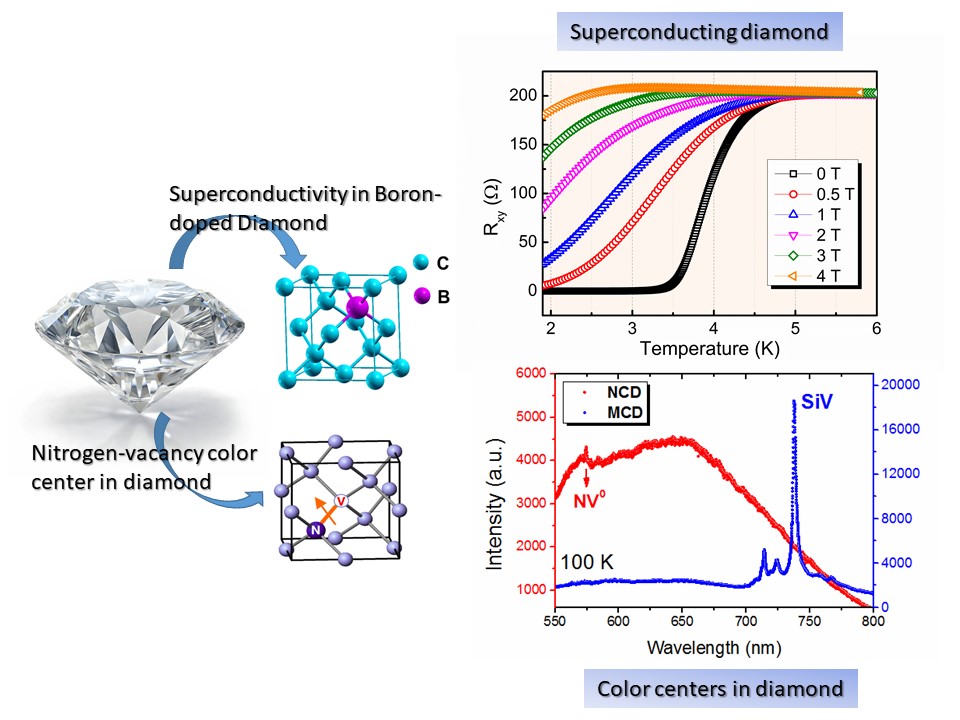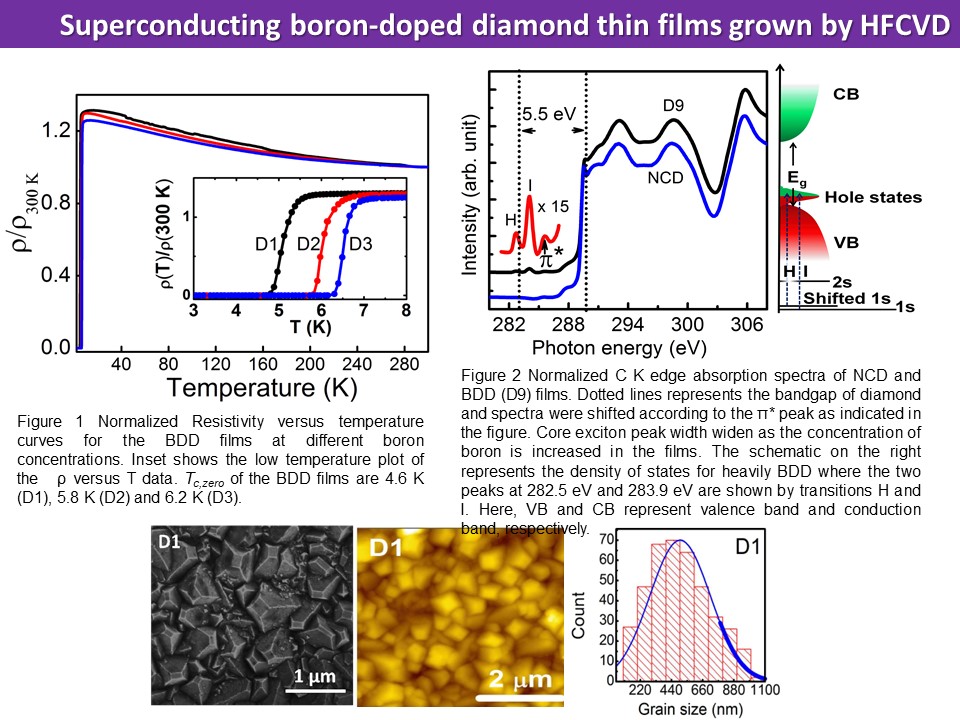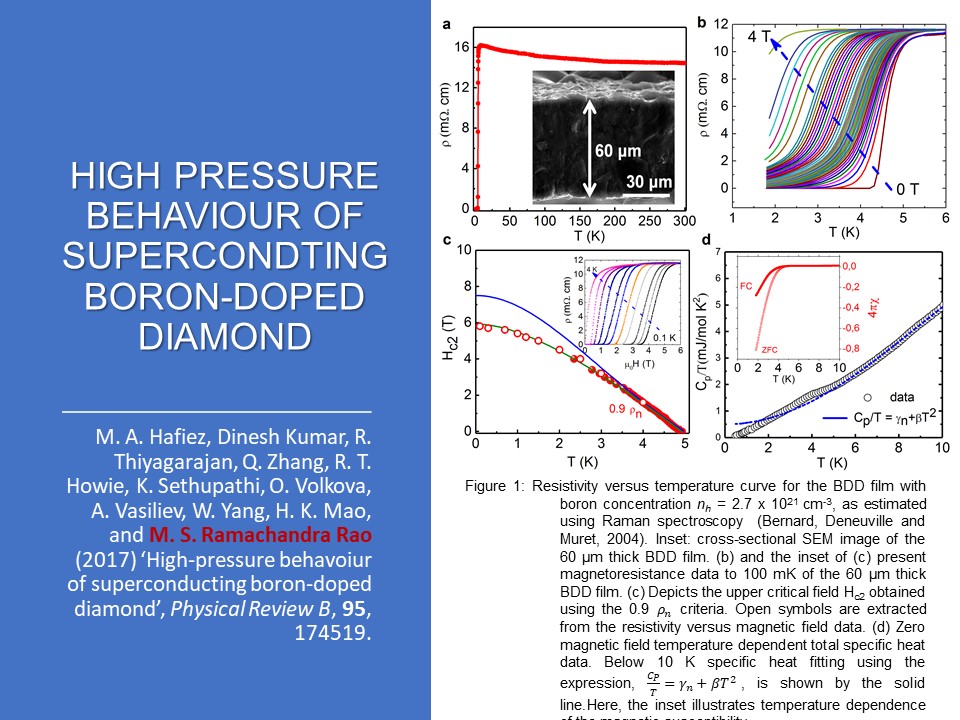- MAGNETISM
- OXIDE ELECTRONICS
- DIAMOND THIN FILMS
- PHOTOVOLTAICS
- 2D MATERIALS
- MULTIFERROICS
- SUPERCONDUCTIVITY
Spin transport in Oxide heterostructures
Spintronics is an emerging technology, which has been extensively investigated in the recent past. Generation, transportation and detection of spin in a controlled manner are very important in spintronic devices. There are several ways one can generate spin current for example from spin Seebeck effect and spin pumping effect. The conversion of charge current to spin current is known as Spin Hall Effect (SHE) and the inverse phenomenon is Inverse SHE (ISHE). The detection of spin is usually realized by the ISHE. The paramagnetic metals such as Pt, W and Ta are widely used for ISHE. Recently, Spin Hall magnetoresistance (SMR) has been studied as an important tool to investigate the conversion of charge to spin and vice-versa. SMR arises due to the simultaneous effect of SHE and ISHE in a bilayer heterostructures consisting of ferromagnetic (or ferrimagnetic) insulator and a normal metal (NM).

ADMR data of a Bi:YIG(54)/Pt(4) bilayer (panels (a), (c), and (e)) and a Bi:YIG(54)/Ga:ZnO(8)/Pt(4) trilayer (panels (b), (d), and (f)) sample grown on YAG (111) substrates.
Magnetic Proximity Effect (MPE) observed in YIG/Pt complicates the spin transport scenario with additional effects such as Anomalous hall effect (AHE) which attenuate SMR signal.7. Our group has successfully studied Ga: ZnO insertion on Bi: YIG/Pt and observed SMR signals, but the increase in spurious paramagnetic signal hampered the SMR signals with increasing Ga: ZnO thickness6. A solution for this is to employ antiferromagnetic moments, which are quite stable to stray fields and MPE. Recent studies in this direction has proved successful in generating spin current using antiferromagnetsNiO/Pt, Cr2O3/W, CuIr and SrMnO3/Pt layers8,9,10. Recent theories and experiments carried out by various groups to use spin current as a detection method to probe interface magnetism in heterostructures. Currently we are working on this direction with our German Collaborators (Prof. Rudolf Gross, WMI Garching, Germany)
Magnetic Nanoparticles Synthesis, physics and applications
Synthesis and assembly of magnetic nanoparticles have attracted great attention because of their potential application in ultrahigh-density magnetic recording, ferrofluids, magnetic resonance imaging (MRI), cell and DNA separation, magnetically guided drug delivery, magnetic fluid hyperthermia (MFH), etc. The size distribution of the nanoparticles is one of the key parameters that determine the physical and chemical properties of the nanocomposite. Magnetic hyperthermia is a type of cancer treatment proposed to increase the temperature of the body tissue to about 42oC using the heat generated from magnetic nanoparticles. Conventional cancer treatment methods such as surgery, chemotherapy and radiotherapy have side effects associated with them and hence MFH is considered as an alternative in cancer therapy. The MFH is claimed to destroy cancer cells selectively, when the nanoparticles are surface modified for their selective absorption on cancer cells.

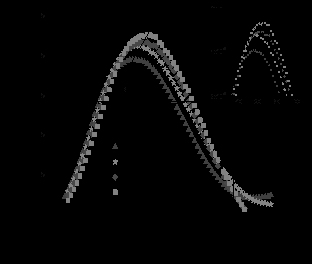
Underlining physics and applications of ZnO thin films, hetrostructures and nanostructures:
- With the increasing demand in the field of optoelectronics, transparent electronics, piezoelectrics and spintronics; ZnO becomes a potential oxide counterpart for GaN and other III-V semiconductors. Naturally ZnO grows in a stable wurtzite-hexagonal crystal structure with a wide band gap of 3.35 eV and a room temperature exciton binding energy of 60 meV, which makes the material promising for the fabrication of UV LEDs and lasers. In spite of these intriguing properties, an assortment of unrevealed physics is to be explored in this material. Our central interests in this material are,
- Growth of high quality and stable p-type ZnO thin films
- Achieving room temperature ferromagnetism in transition metal ions (Co, Mn, Ni and Fe) doped
- ZnO thin films and nanostructures
- Fabrication of highly transparent and flexible ZnO thin films for transparent electronics
- Growth of ZnO nanostructures and its functional properties
- Synthesis of white light emitting ZnO based nanocomposites phosphor
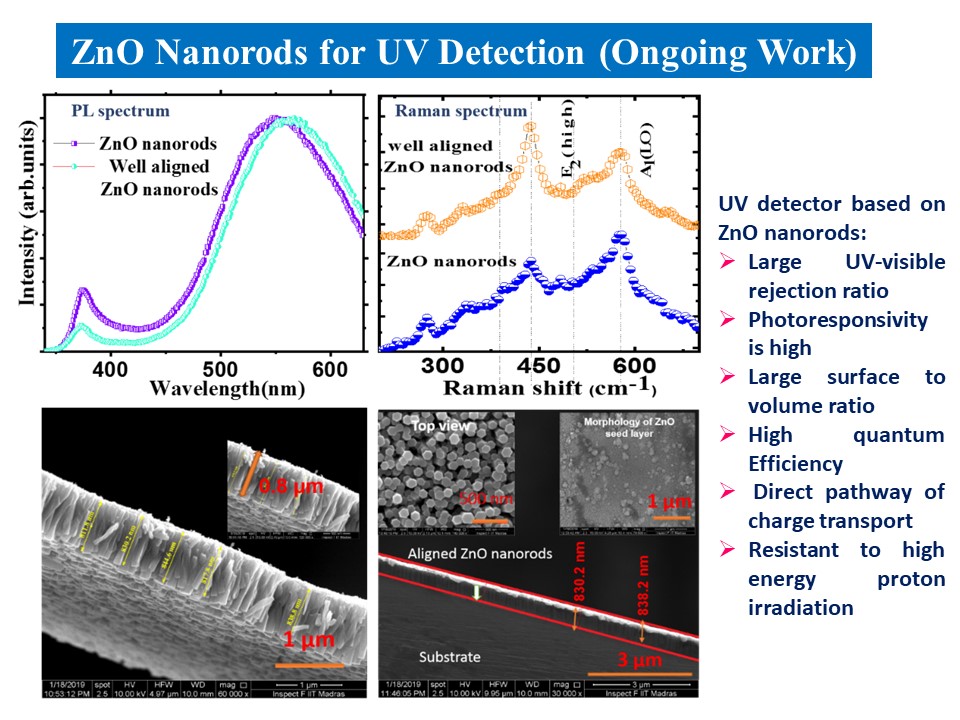
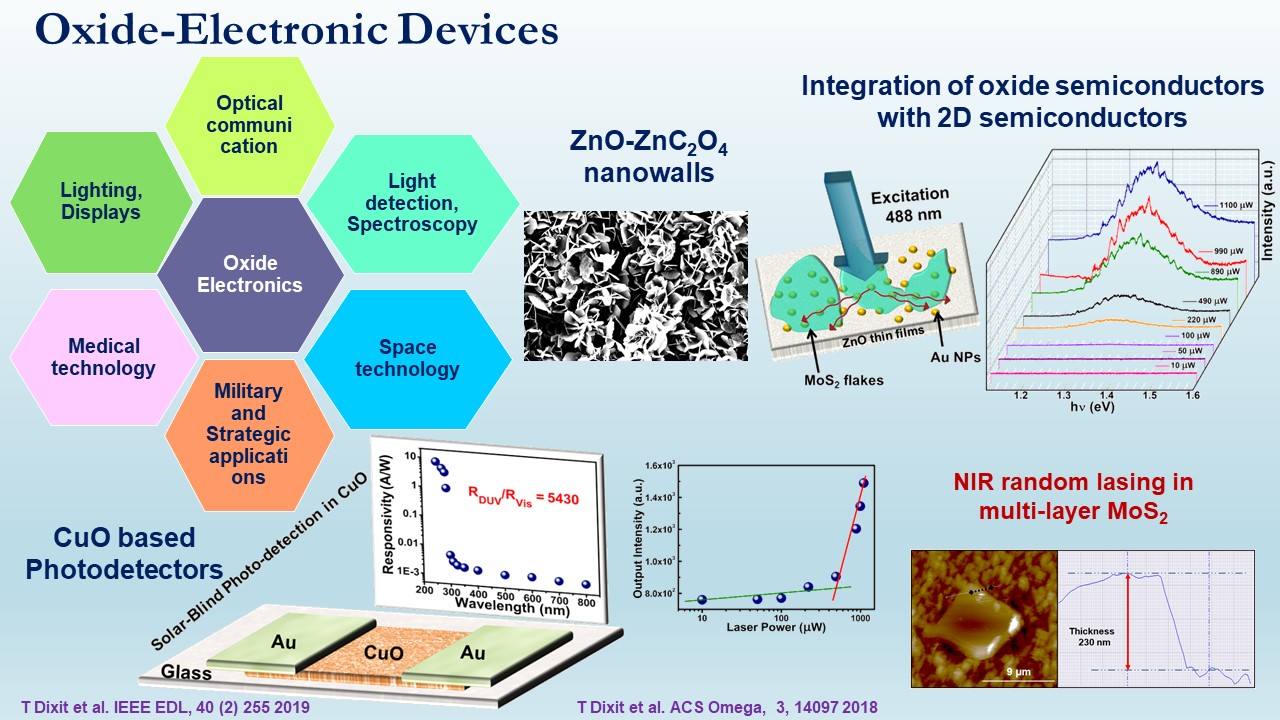
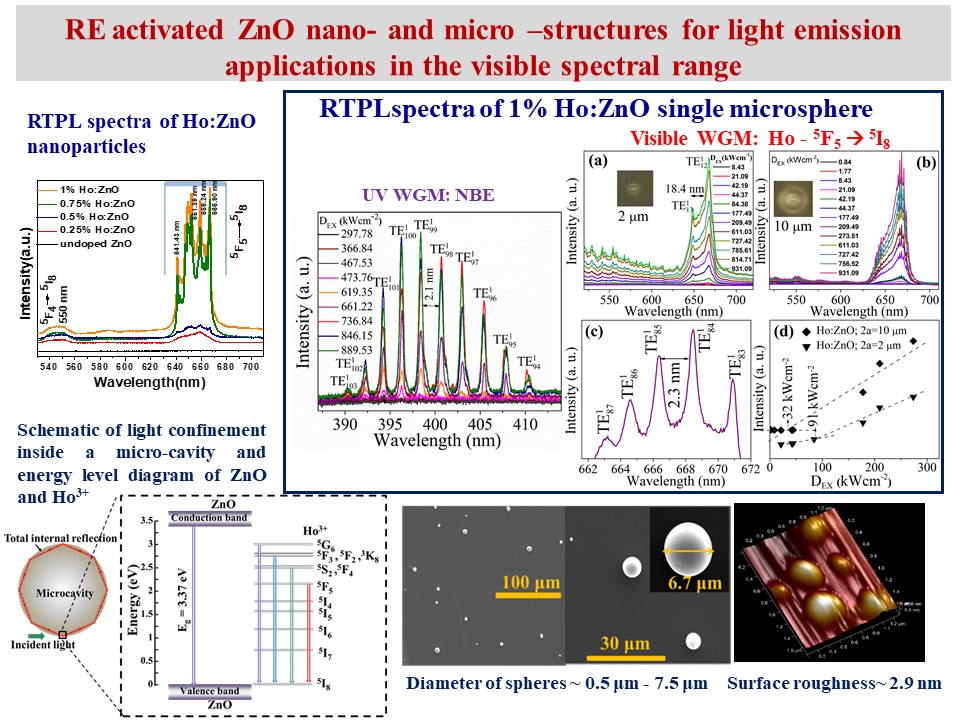
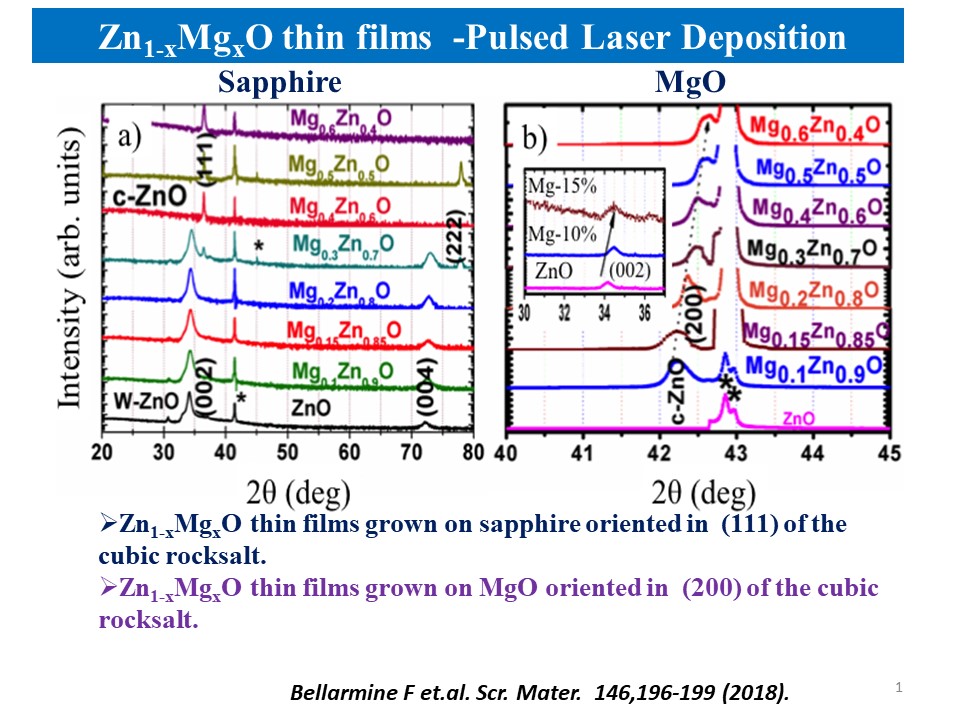
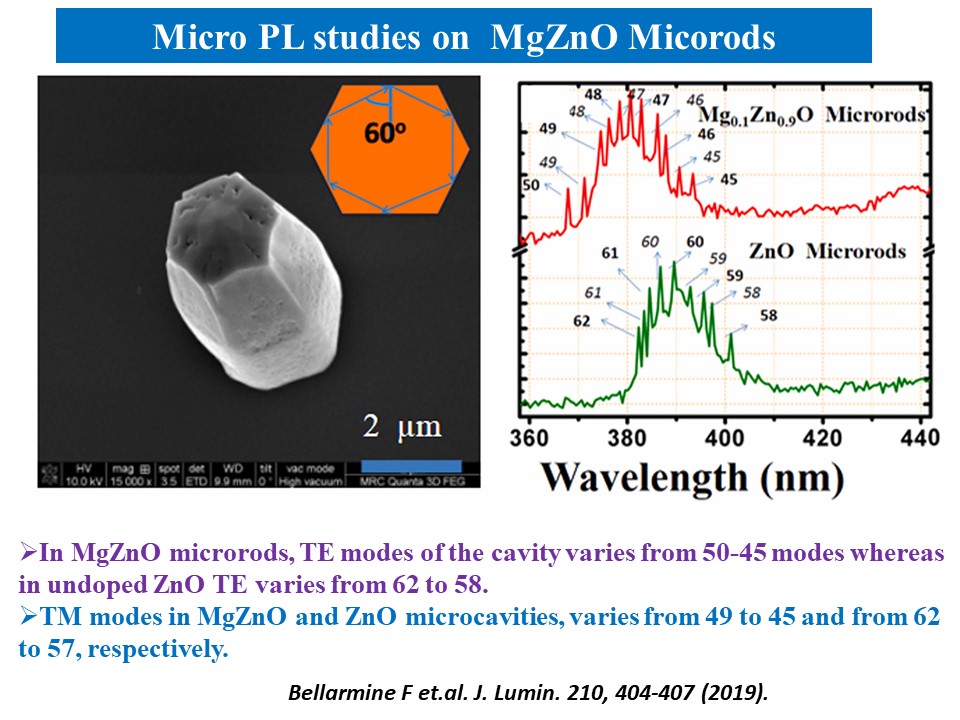
CVD Diamond Thin Films :
Diamond, an allotrope of carbon, has always attracted a great deal of interest in many fields of science and engineering owing to its outstanding fundamental properties and technological applications. Diamond is most frequently found in face centered cubic form in which each carbon atom is linked to four other carbon atoms by sp3 σ bonds in a strain- free tetrahedral array. In brief, diamond is very hard (100 GPa), optically transparent (deep UV to FIR), excellent thermal conductor (2000 Wm-1K-1) at room temperature, good electrical insulator (1016 Ω-cm), more resistant to X-rays, gamma-radiation, UV light and nuclear radiation, and it has the highest acoustic velocity (18000 ms-1), and very resistant to chemical corrosion. Therefore, several potential applications are anticipated in many fields, which include tribology, electronics, optics, acoustics and electrochemistry. Diamond already finds use in many diverse applications including as thermal spreader, wear-resistant coatings for cutting tools, high power laser windows, particle detectors etc.
A majority of diamond applications require a highly adherent diamond thin films deposited onto non-diamond substrates. We explore the possibility of realizing the growth of diamond on different substrates (Si, SiC, Ti, Cu, WC etc), adhesion of the deposited films, surface morphology studies and interface studies. Diamond films are deposited using hot filament CVD (HFCVD) reactor. We study the effect of interlayer(s) (TiAlN, TiCN, TiN etc) as an effective way of improving the adhesion of CVD diamond to tungsten carbide tools. Besides, we do boron doping to realize the p-type conductivity in diamond thin films. Precise process controls can produce ultra-smooth, nanocrystalline diamond (NCD) coatings (less than 100 nm) or rougher micro-crystalline structures. The deposited films are characterized using Raman spectroscopy, XRD, SEM, AFM and nanoindenter etc.
Diamond coating for mechanical applications
Extreme hardness (100 GPa), very high thermal conductivity (2000 W/mK), chemical inertness and low friction coefficient (<0.1) properties makes diamond the a supreme material for several mechanical applications. Diamond can be made in form of thin films on a complicated shape of the component through hot-filament CVD reactor method. The utilization of Diamond coated tools are classified into two sections namely machining and forming industries.

The lightweight material such as high strength aluminum alloys (Al-6061) and aluminum-based composites (Al-SiC) are widely used in automobile and aerospace industries due to its improved properties such as high strength to weight ratio, high wear resistance, high thermal conductivity and good corrosion resistance. However, these materials encountered certain challenging task during machining. Al-6061 alloy has a tendency to stick on the cutting tool which facilitates wear on the rake and flank surface of the cutting tool. Al-SiC MMC consists of two phases such as primary matrix Al and hard SiC particles. These two phases contribute severe wear on the cutting tool edges. The improvement of diamond-carbide interface adhesion strength through boron doping makes diamond coated WC-Co tools an appealing alternative for machining these two materials [1]. The results of machining study show a significant improvement in tool life with the use of the Boron-doped graded layer diamond coated tool when compared to uncoated counterpart as shown in Fig.2. The chemical inertness of diamond coating avoids build-up edge formation and produces a smooth surface finish as shown in Fig.3. On the other hand titanium (Ti6Al4V) alloy is widely used for fabricating frames and components in sectors such as aerospace, marine, and chemical, to name a few. This is due to the superior properties of this alloy such as high strength to weight ratio and good corrosion resistance which also create bottlenecks in the machining of this alloy during traditional manufacturing processes. Due to its poor thermal conductivity of titanium alloys, localized heat can alter the geometry of the cutting tool through plastic deformation during machining. In this regard diamond coated tools found to be a suitable cutting tool for machining of this high-performance alloy due to its high thermal conductivity and high hot hardness [2]. The machining results show a significant improvement in the use of BDD-MCD (boron doped – microcrystalline diamond) coated tool when compared to uncoated counterpart as shown in Fig.4. This paves the way for the development of a low-cost alternative for enhancing the life and hence productivity of machining in critical sectors [3]. With respect to metal forming industries, particularly in tube drawing sector (Tube Investments of India Ltd, Avadi), the main problem encountered is the gradual wear of WC-Co die with time and making it incompatible to meet the surface integrity and dimensional requirements of the drawn products. The very low friction coefficient of the nano-crystalline diamond coating (shown in Fig.5) results in reduced drawing forces and improved surface integrity of drawn tubes [4] as shown in Table.1. NCD coatings on high speed steels (TII) yields less friction and homogenous deformation during coining test as shown in Fig.6. With the outcome of all these potential research, Kapindra Precision Engineering PVT Ltd incubated at IITM Research park converting all these lab scale development into the industrial usage under the support provided by Prof.MS.Ramachandra Rao (Physics, IITM) followed by Dr.N.Arunachalam (Asst.Professor,Mechanical, IITM) and Dr.Satyan subbiah (Associate Professor, Mechanical, IITM).
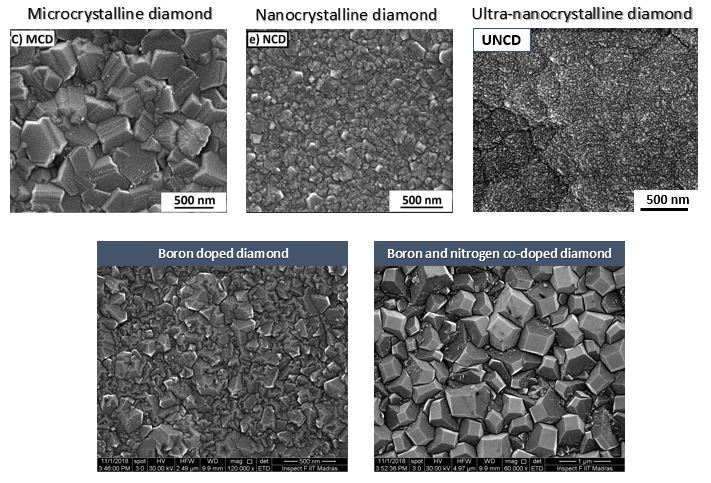
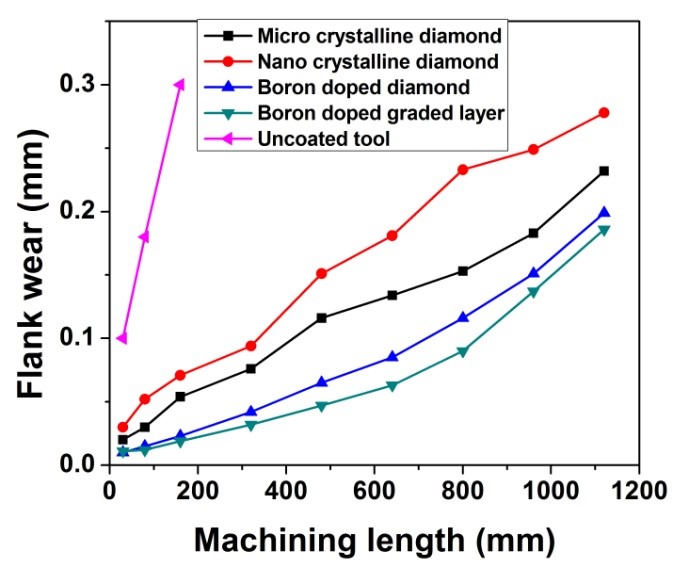
Diamond thin films for SAW devices
Integration of piezoelectric materials on diamond substrate offers a great opportunity for the application of multifunctional devices under extreme conditions. However, fabrication of perovskite lead zirconate titanate (PZT) thin films on diamond substrate has not been realized to date, without a buffer layer. We first reported on the successful deposition of perovskite PZT thin film directly on a diamond substrate without any buffer layer using the pulsed laser deposition technique. Since diamond has the highest known acoustic wave velocity, integration of perovskite PZT directly on a diamond substrate can easily find applications in high frequency surface acoustic wave (SAW) devices.
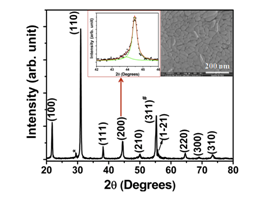
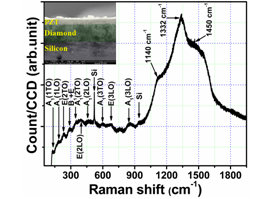
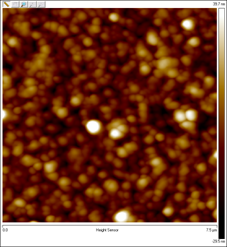
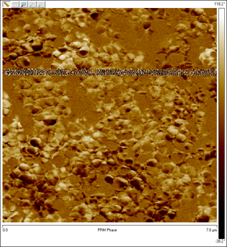
Diamond thin films on WC-Co substrates
Diamond films on cemented tungsten carbide (WC-Co) substrates have attracted a considerable attention due to the possibility to combine the toughness of cemented carbide with the hardness of diamond resulting in an outstanding wear resistance property. We addressed an industrial problem and optimized the process parameters to produce smooth, fine grained nanocrystalline diamond coatings on the interior of WC-Co drawing dies. Diamond coated WC-Co drawing dies showed an improvement in the quality of drawn tubes in terms of surface finish and lower residual stress.
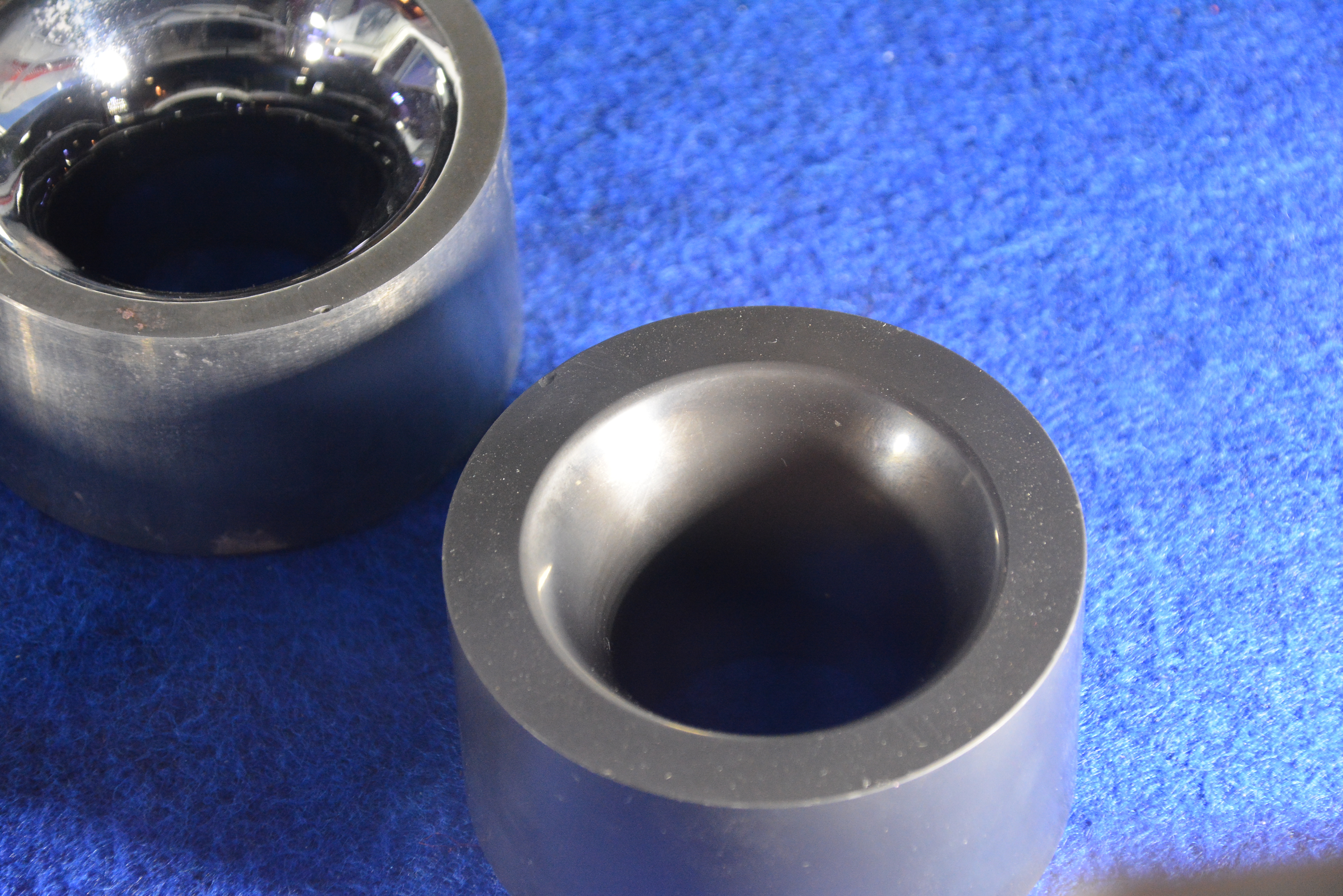
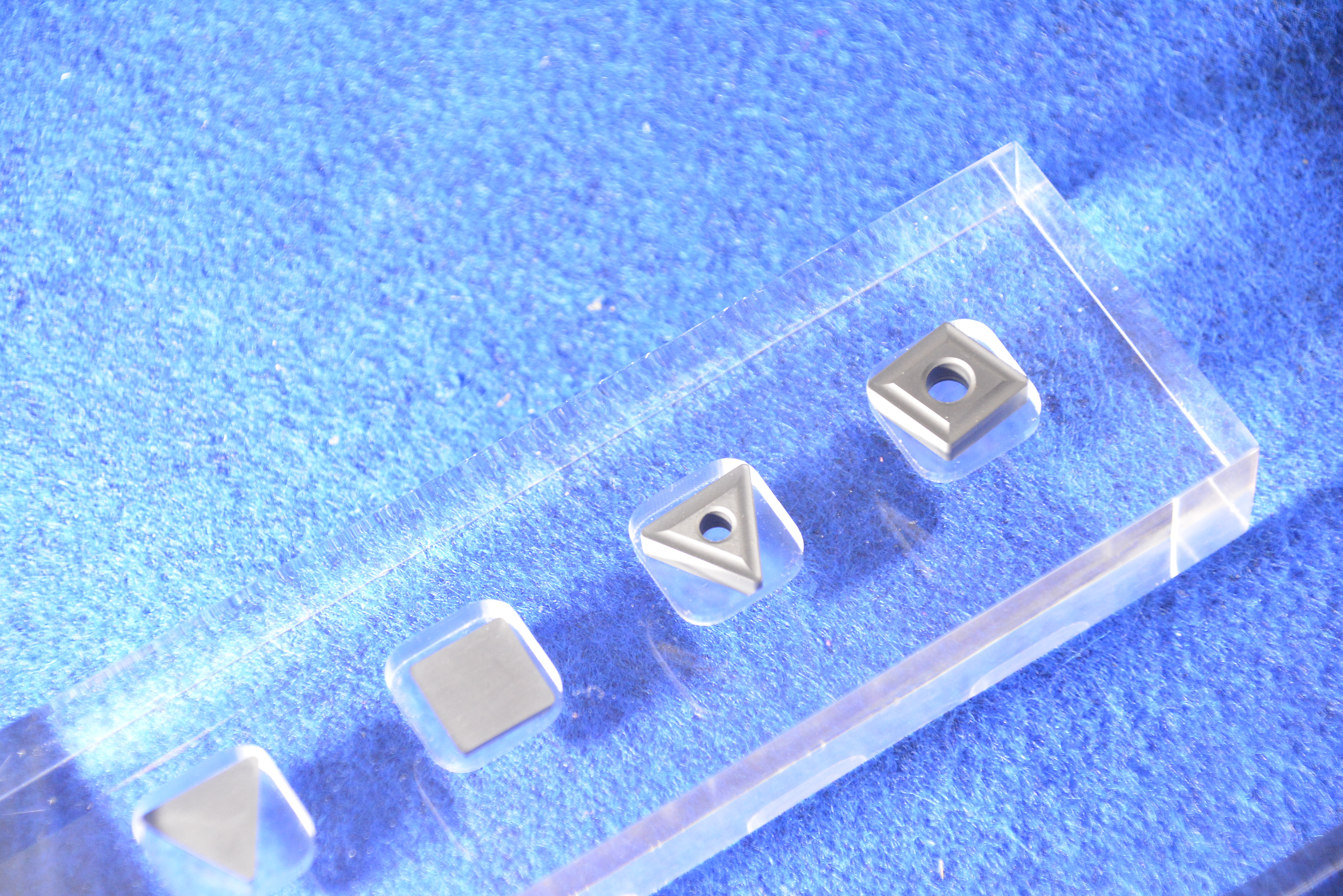
CVD diamond coated cutting tools have the advantages of low cost, and can be applied to tools with complex shape such as drill bits, reamers and end mills. The fundamental problem of these diamond coatings is the coating de-lamination under high mechanical stresses during machining. A main effort to improve the performance of diamond coatings nowadays concentrates on the improvement of the coating adhesion.
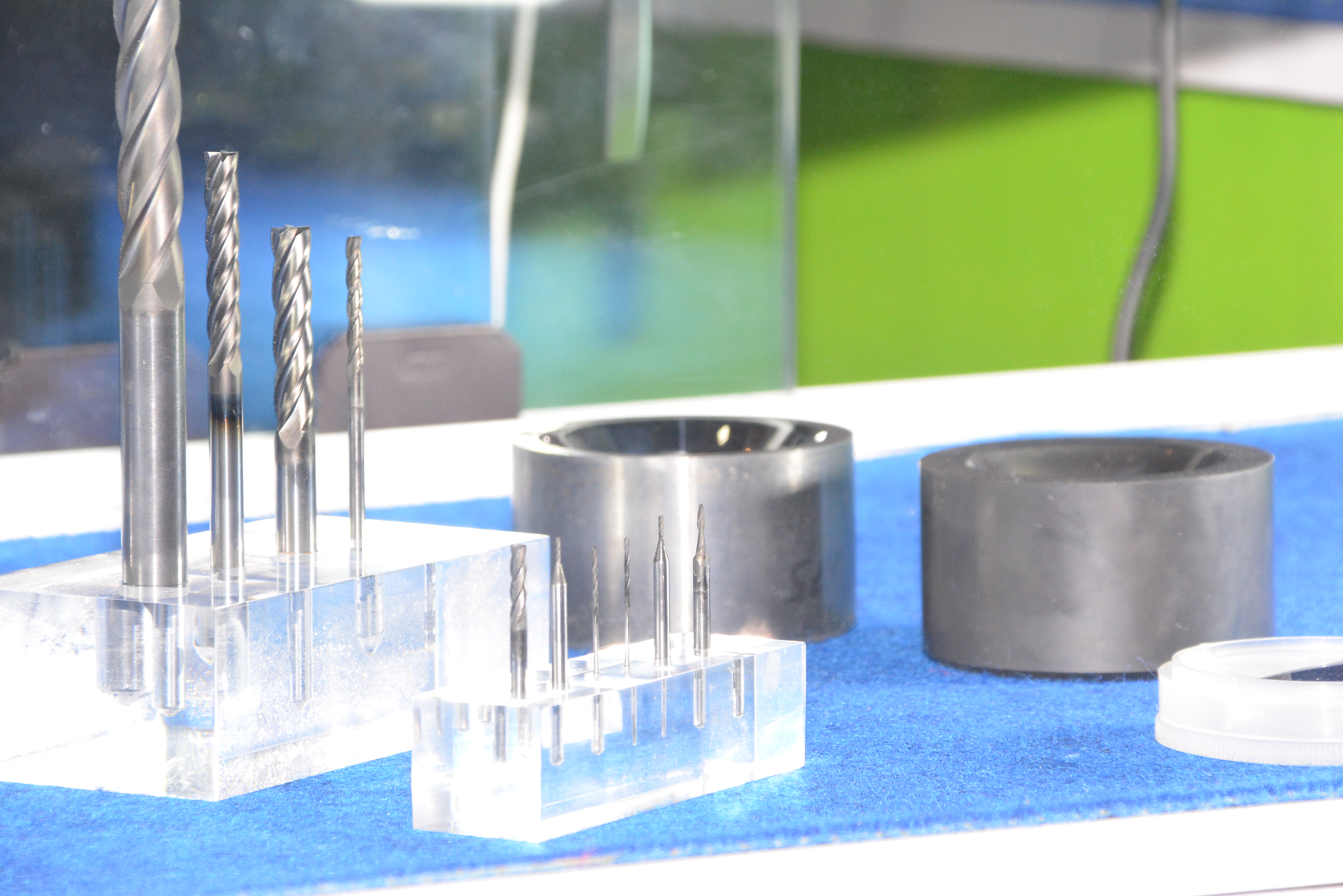
- Ramasubramanian, K., Arunachalam, N., and Ramachandra Rao, M. S., 2017, "Investigation on tribological behavior of boron doped diamond-coated cemented tungsten carbide for cutting tool applications," Surface and Coatings Technology
- Balaji, S., Rao, M. S. R., and Balkrishna, C. R., 2017, "On the development of a dual-layered diamond-coated tool for the effective machining of titanium Ti-6Al-4V alloy," Journal of Physics D: Applied Physics, 50(1), p. 015302
- R Dumpala, M Chandran, S Madhavan, B Ramamoorthy, MSR Rao, High wear performance of the dual-layer graded composite diamond coated cutting tools, International Journal of Refractory Metals and Hard Materials 48, 24-30
- M Chandran, CR Kumaran, R Dumpala, P Shanmugam, R Natarajan, MSR Rao, Nanocrystalline diamond coatings on the interior of WC–Co dies for drawing carbon steel tubes: Enhancement of tube properties, Diamond and Related Materials 50, 33-37
- References:
Nano-ink based CZTS solar cells:
It has become important to harvest solar energy in order to satisfy our increasing energy demands. In our group, we work on CZTS thin film solar cells. In order to avoid the processing cost of vacuum based deposition methods, we have developed simple chemical methods to prepare and deposit CZTS and CdS on desired substrates. The following schematic explains the process involved in preparation of CZTS solar cell.
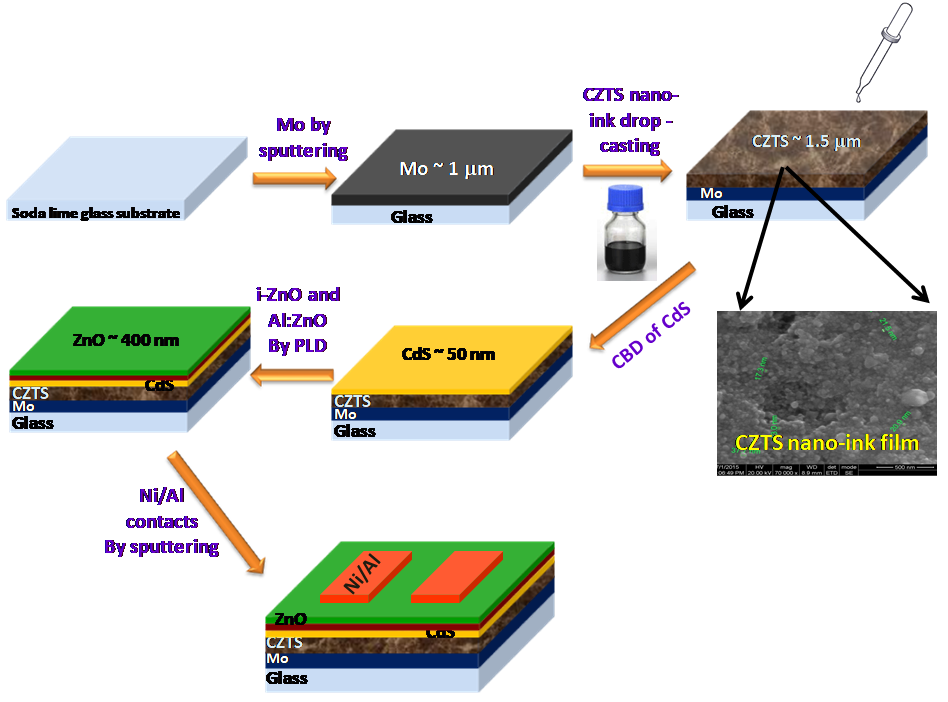
Molybdenum layer serves as metal back contact, which we deposit on soda lime glass by sputtering. CZTS acts as absorber layer in the solar cell. We have developed a method to prepare the CZTS nano-ink by hot injection technique. This CZTS nano-ink is deposited on Mo coated soda lime glass by simple drop casting or Doctor’s blade method. The CdS buffer layer is then deposited on it by chemical bath deposition (CBD) method. Transparent conducting oxide is deposited then by Sputtering or Pulsed Laser Deposition (PLD). To get the final device architecture, we deposit metal contacts by sputtering/thermal evaporation. We are optimizing all the layers in order to get efficient solar cell.
We have studied the defect study in the polycrystalline CZTS thin films by Raman spectroscopy. Change in Cu stoichiometry and variation in incident laser beam intensity both induce a disorder in the system giving rise to a disorder phonon mode at 331cm-1 corresponding to partially disordered Kesterite structure (PD-KS). We predict that correlating basic defect physics of material and its influence on phonon spectrum to transport properties may reveal the mechanism behind surge in efficiency under non-stoichiometric conditions. (Sunil Kumar Samji et.al, Appl. Phys. Lett. 104, 152106 (2014)).
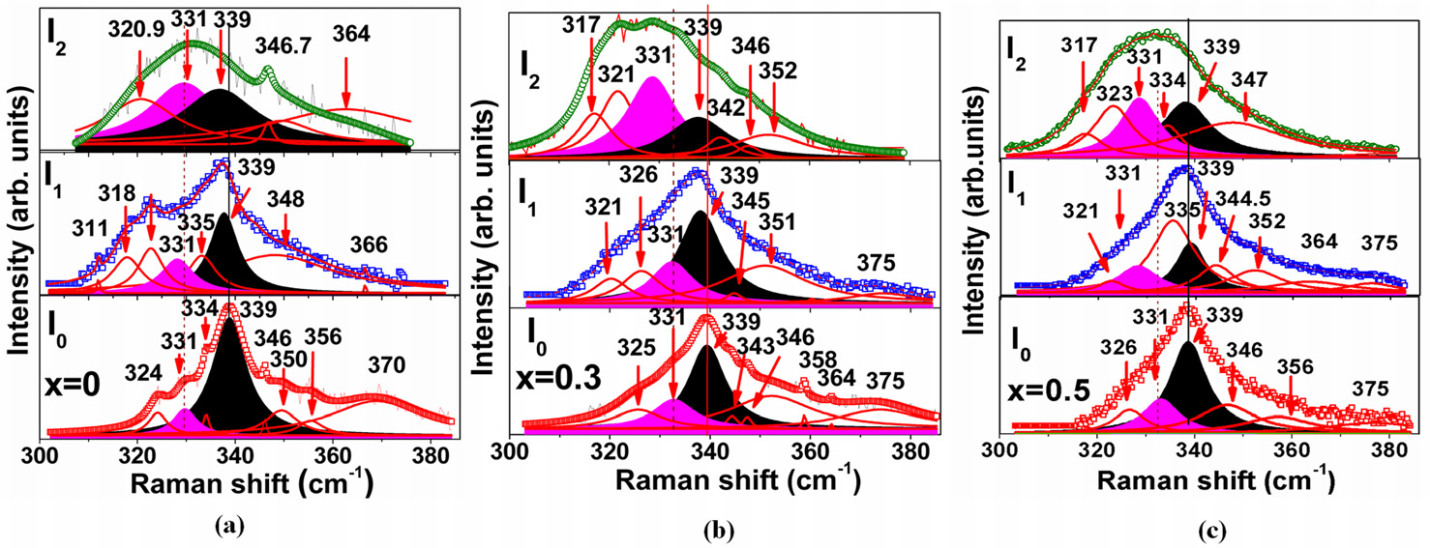
Fig: Raman spectra of Cu2-xZnSnS4 thin films recorded at three different intensities of incident laser beam I0, I1 (10 I0) and I2 (25 I0) corresponding to different Cu-content, (a) x = 0, (b) x = 0.3, and (c) x = 0.5.
Formation of ordered defect compounds and anomalous grain boundary physics are unique to Cu chalcogenides CuInX2 (S/Se) and its alloys. We have focused on defect physics i.e., possibility of formation of ordered vacancy compounds as well as grain boundary (GB) physics in quaternary systems. X-ray photoelectron spectroscopy (XPS) studies were carried on Cu2-xZn1.3SnS4 (x= 0.0, 0.3, 0.5 and 0.7) thin films to determine the position of valence band edge and explore the formation of ordered vacancy compounds along with absorption studies. To understand GB physics, we have studied CZTS thin films with Conductive atomic force microscopy (C-AFM) (S.K. Samji et al., Scripta Materialia 117 (2016) 11–15).
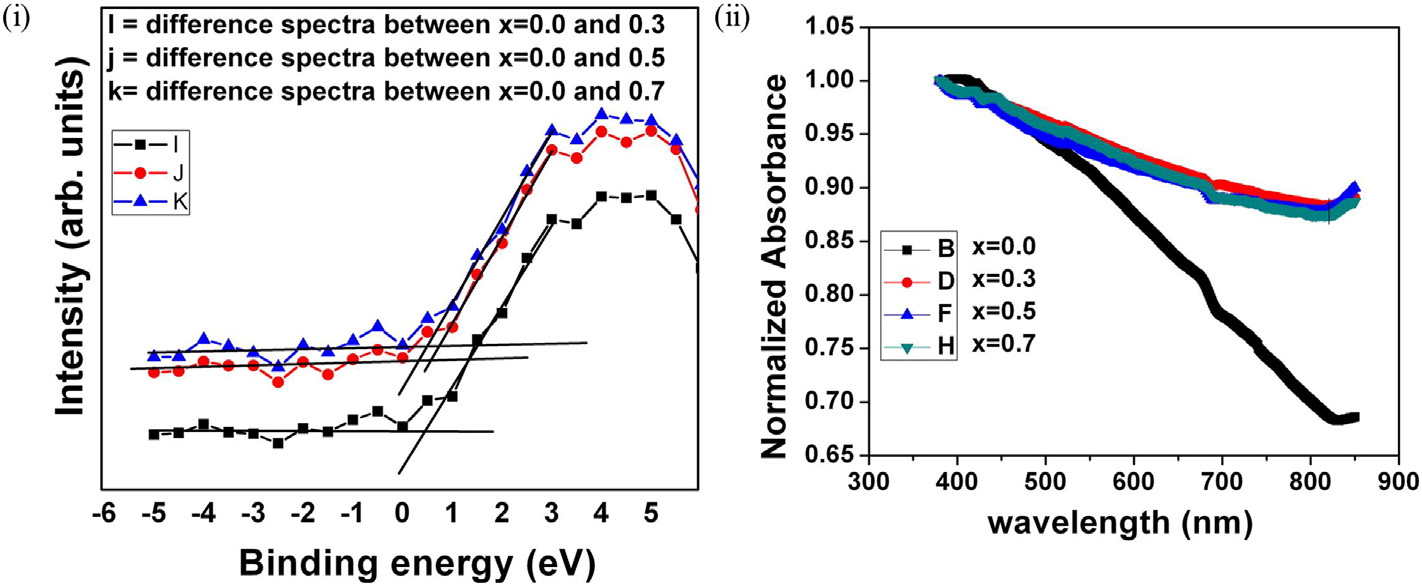
Fig.4: (i). Difference spectra obtained by subtracting the intensity of valence band edge of Cu2-xZn1.3SnS4 (x=0.3, 0.5 and 0.7) from x=0.0 composition, (ii) absorption spectra of Cu2-xZn1.3SnS4 (x = 0.0, 0.3, 0.5 and 0.7) recorded in the visible region.
We are also interested to study the electrical transport properties of the absorber material CZTS as it plays an important role in the solar cell performance. We are carrying out the temperature dependent resistivity studies with samples of different thickness to explain the mechanism of the electrical conductivity in the absorber material
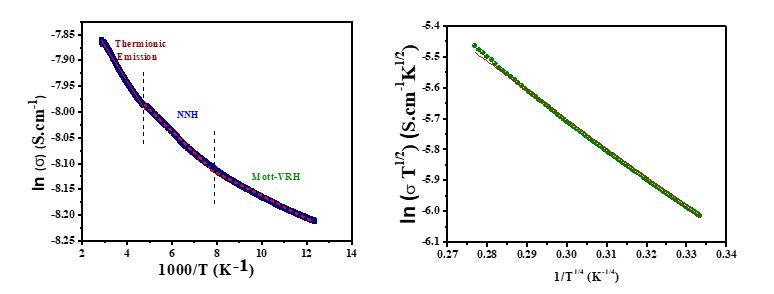
Fig: ln(σ) vs inversion of temperature of CZTS thin films
Perovskite solar cells
The first efficient state Perovskite cells were reported by mid-2012 and then after extremely rapid progress is reported in the following years where the cell efficiency reached 16.2 % by the end of 2013. Again this value reached 17.9 % in 2014 and presently achieved a value more than 20%. These values showed that this technology is capable of producing solar energy comparable to the conventional solar cells and it can be mass produced with printing techniques from inexpensive and abundant perovskite materials. Solar cell applications feature mostly the organo-metal halide perovskite materials with stoichiometry AMX3, where M is typically a divalent metal ion such as Pb2+, Sn2+, and Ge2+ while X is a halide anion such as I-, Cl- and Br- and A is an organic cation. Some of the advantages of perovskite structure are ease of manufacturing, strong absorption of solar energy, lower carrier recombination, higher charge carrier mobility and higher carrier lifetime, which confirms the availability of charge carriers to be extracted as electric current. Some of the negative sides of the perovskite solar cells are its instability to the moisture and UV, usage of lead as a major constituent, which is having toxic issues during fabrication, usage, and disposal.
- Our group focus on replacing the standard hole transporting and the electron transporting layers with novel materials which can produce high-efficiency solar cells. Electrical and optical properties of each layer are also evaluated with simulation and corresponding experimental results to optimize each layer thickness and hence to achieve the best solar cells.
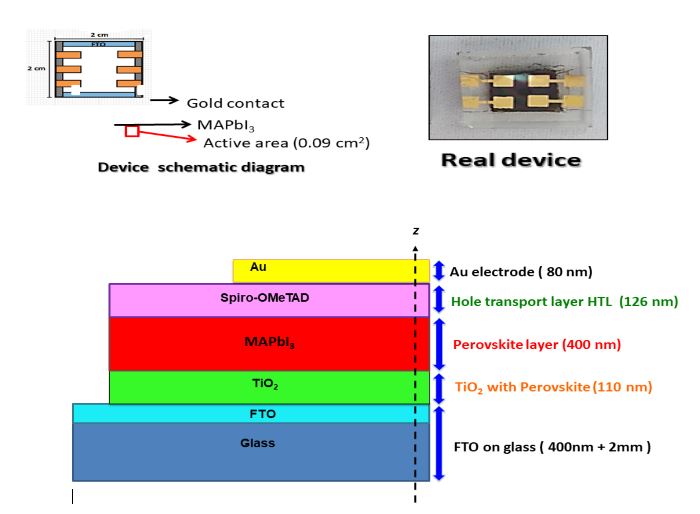
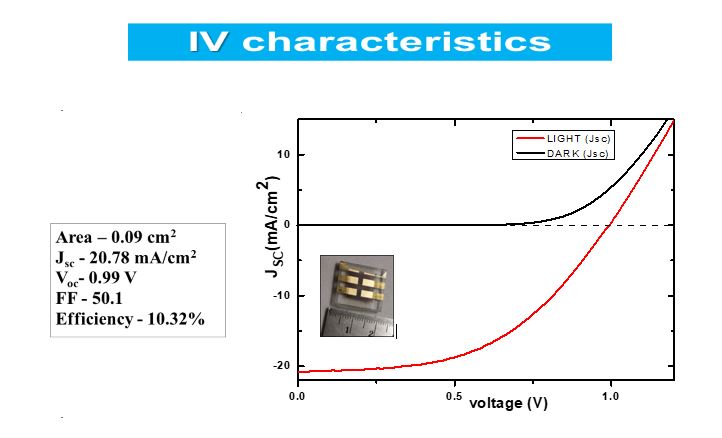
Diamond thin films on silicon substrates
Layered materials, most commonly Vander Waals materials with anisotropy in bonding were the common source of 2D materials. Graphene was the first and well-studied candidate in the 2D family, discovered in 2004. However, many other 2D materials, which came later-onand can be prepared in the laboratories by simple exfoliation and various other deposition techniques e.g. Hexagonal boron nitride (h-BN) and Transition Metal Dichalcogenides (TMDs), fall under this category. These materials drawn enormous attention in the material science community due to their supreme properties, which makes them a better and reliable candidate for various electronic, opto-electronic and photonic applications.
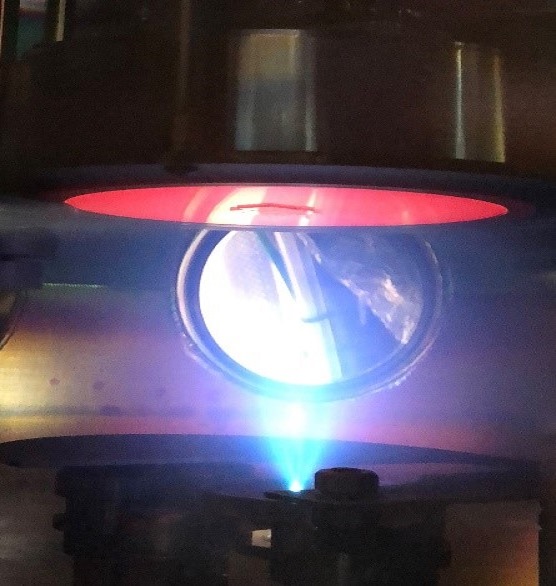
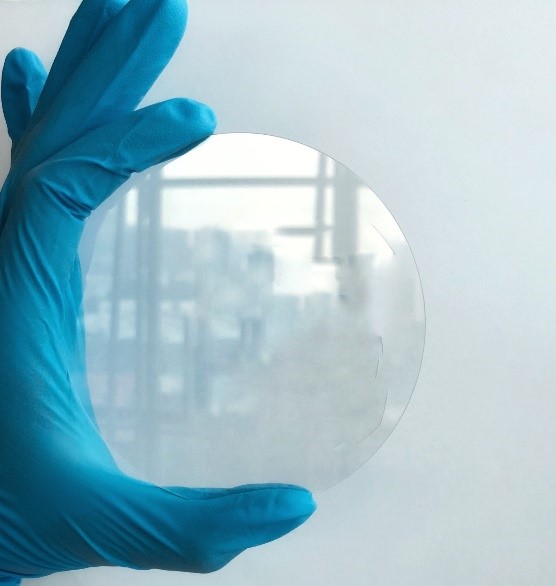
Wafer scale growth of 2D materials via Pulsed laser deposition. Especially large area growth of reduced graphene oxide (rGO), MoS2 and WS2 were enabled by PLD. Systematic tuning of their thicknesses and stoichiometry helps in achieving the opto electronic tunability of the grown thin films. Moreover, this Physical vapour deposition growth mechanism helps to attain highly uniform, good quality large area thin films with desired opto-electronic properties.
Graphene, a wonder material known for its all intriguing properties posses very high potential towards thermal management applications. Due to its extremely high thermal conductivity, even higher than the best bulk heat conductor diamond, it is considered as a heat superconductor which can be readily used for heat management applications in electronic and optoelectronic devices. Hence understanding the heat flow mechanism in graphene as well as the role of material parameters like strain, defect density and rotation angle in bi-layer graphene posses immense importance. So basically we investigate the heat flow mechanism in 2D material systems and the role of different material parameters on the thermal properties.
Ferroelectric FET for Non-volatile Memory: MoS2 Fe-FET devices with epitaxial PZT as back-gate exhibit low switching voltages ≤ 2 V which is much lower than the reported 2D-FET devices (8 - 20 V), high ON-OFF ratios ≥ 104 which is comparable to state of the art Fe-FET devices and reproducible hysteresis behaviour with good sustainability over 200 cycles switching operation. This study paves the way to the realization of low power and reliable non-volatile memory devices.
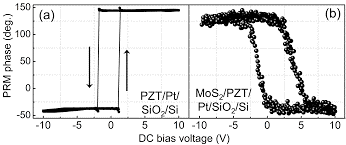
More information: Kolla, Lakshmi Ganapathi, Martando Rath, and MS Ramachandra Rao. "Polarization induced switching in PZT back gated multilayer MoS2 FETs for low power non-volatile memory." Semiconductor Science and Technology (2018). https://doi.org/10.1088/1361-6641/aaf9e6.
Cavity-less NIR LASER for biological applications: MoS2 /Au Nanoparticles/ZnOheterostructures were designed to obtain room temperature near infrared region (NIR) random lasing (800-950 nm), with a threshold of nearly 500 μW. This work provides new dimensions towards realization of low power on-chip NIR random lasers made up of bio-compatible materials. The present work opens up new dimensions towards realization of low power on-chip NIR random lasers made up of biocompatible materials.
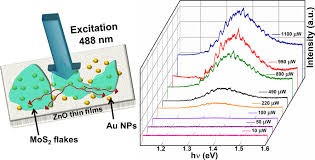
More information: Tejendra Dixit, Ankit Arora, Ananth Krishnan, K. Lakshmi Ganapathi, Pramoda K. Nayak, and MS Ramachandra Rao. "Near Infrared Random Lasing in Multilayer MoS2." ACS Omega 3, no. 10 (2018): 14097-14102. https://doi.org/10.1021/acsomega.8b01287
Piezoelectrics and Multiferroics

- 1. Martando Rath, E. Varadarajan, E Natarajan and M. S. Ramachandra Rao, Ceram. Int., 44, 8749–8755(2018).
- 2. Martando Rath, Dinesh Kumar and M. S. Ramachandra Rao, Appl. Phys. Lett., 113, 066829 (2018 )
- 3. Lakshmi Ganapathi Kolla, Martando Rath and M S Ramachandra Rao, Semicond. Sci. Technol., DOI: https://doi.org/10.1088/1361-6641/aaf9e6
- References:
Superconducting Diamond
